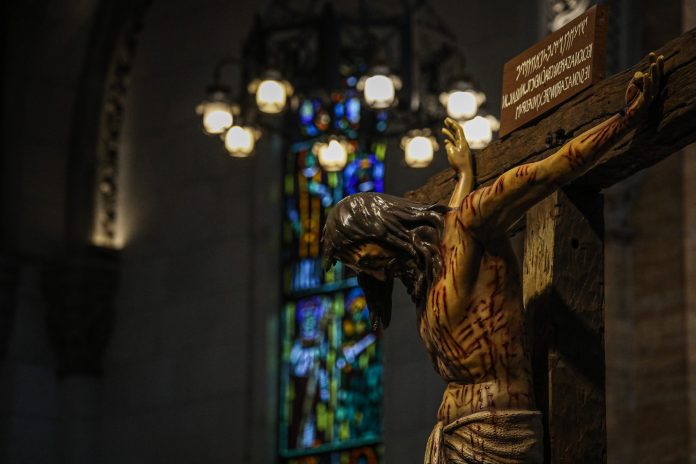[The “Satisfaction Model” of the Paschal Mystery]
The most popular framework for thinking about Jesus’ passion, death, and resurrection is St. Anselm’s “theory of satisfaction”. “Satisfaction” does not mean ‘indulgence’ and ‘gratification’ as present meanings suggest. In theology, “satisfaction” means reparation, compensation, making amends for a broken relationship, and paying back a debt.
When Adam and Eve sinned, they not only wronged God. They also destroyed God’s order and marred his glory. If we have sinned against God, we have to pay back our debts or mend relationships we have broken. The language we have adopted from the times of slavery is “to ransom”. Someone needs to ransom us.
We then hear these words coming from our catechists: “Jesus ransomed us from the devil”. Or you can read it on jeepney signboards: “You are already saved. You only have to accept Jesus as your personal Lord and Savior.”
Jesus, who is both God and human, is the right being to pay ransom for us in order to restore the destroyed order. Since the offender is a human being, only a human being can make amends. But since it was God who was offended, it is only a divine being who can restore the honor which is due God.
“The honor must be repaid,” St. Anselm says, “or punishment must follow.” Thus, when Anselm asks Cur Deus Homo (why did God become human?), theology’s answer is clear and certain: to make us humans ‘right with God’. Protestant language is the same: “Jesus justified us with God. We were sinners but Jesus made us righteous.” These are also the answers we have learned from our catechism classes: Jesus was a sacrificial victim offered to God for the remission of our sins. Within this framework,
Ironically, St. Thomas Aquinas and John Calvin developed this doctrine in both Catholic and Protestant traditions so much so that it has become very popular from the medieval ages up to our times.
On the Catholic side, this led St. Thomas to talk about the “infinite merits” of Christ’s passion which can be applied to all the faithful. This is also the precursor of the theory of “indulgences”. You must have seen old posters where the priest celebrates Mass at the center while offering the chalice and host to Christ crucified in Calvary. From his pierced side comes living water that quenches the thirsts of souls languishing in purgatory.
In the Protestant camp, Calvin talks about penal substitution. To say it simply, Christ became our substitute. On the cross, he took upon himself our punishment, thus, appeasing God’s wrath. We have already been saved by Christ. What we need to do is to accept him “as our Lord and Savior”, and to be united with him. I was once riding a bus and someone woke me up: a preacher handed to me a small pamphlet that says: “Jesus already paid it in full.”
Regardless of our denominational differences, St. Anselm’s satisfaction model is very much present in popular consciousness from medieval times up to our times. You can hear this in Lenten recollections and Siete Palabras: Jesus has taken and carried the burden of all our sins on his shoulders. As our ancestors had long sung in the Pasyon: “Krus, na yao’y mabigat, labis na nagkakaapat lumulubog sa balikat, at lalo pang nakaragdag ang sala ng taong lahat… Ikaw rin at hindi iba, totoong lunas sa sala, ang lasap mo’t ibubunga, siyang makagiginhawa sa tanang anak ni Eba” (Pasyong Mahal).
If we ever go through some suffering in our lives, it is but a meager sharing in the One who has already paid our debts for us. This way of thinking about Christ’s paschal mystery also has its roots in the Scriptures. St. Paul says: “God was in Christ reconciling the world to himself” (2 Cor. 5:19). “You are not your own; you are bought with a great price” (1 Cor. 6:20). In the Book of Revelation, one reads: “You are worthy to take the scroll and to open its seals, because you were slain, and with your blood you purchased men for God from every tribe and language and people and nation.” (Rev. 5: 9).
However, in contemporary times, we do not quite understand the quite juridical and commercial language with which this model expresses the divine-human relationship: atonement, ransom, substitution, repayment, reparation, etc.
Some people in fact ask these difficult questions which this model fails to answer: “How can a God be so cruel to allow his Son to be crucified just to restore the honor due Him?” “I thought God is loving and forgiving? Why does he care about repayment at all? What happens with the Parable of the Prodigal Son?”
Consequently, to drum up the violent language of ransom, sacrifice, and victimhood on people who are already beaten, trampled upon, and abused by the dominant powers does not at all announce the good news that the paschal mystery is supposed to bring.
There is thus a need to look for other models that can truly express God’s liberating action in our lives.
Father Daniel Franklin Pilario, C.M., is the President of Adamson University in Manila. He is a theologian, professor, and pastor of an urban poor community on the outskirts of the Philippine capital. He is also Vincentian Chair for Social Justice at St. John’s University in New York.









